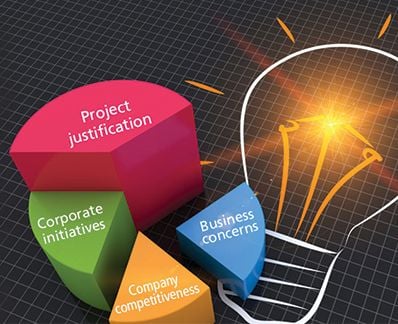This post was authored by Dick Hill, vice president and general manager of manufacturing advisory services at ARC Advisory Group.
Clearly, any new automation project requires economic justification. Although this often involves hard "dollars and cents" quantification of cost savings from increased production, reduced raw material costs, or increased uptime, it is also about "soft" benefits, such as reducing risks and improving agility. All contribute to making your company more competitive. This article will focus on the latter, while also highlighting considerations for the former. It will also share some best practices that ARC Advisory Group has identified.
When considering a change of any kind and researching the alternatives, it is very important to understand that your business is likely to be flooded with opportunities to invest capital and that change needs to be justified for the benefit of the company. Personal or department goals need to be subordinated to corporate goals. In the automation domain, a number of factors should be evaluated for their economic contributions to a justification. But it does not end there. Justification must take into account the broader opportunity to better position your company for future competition, likely involving greater agility, additional products, or improved quality.
Example items to consider in a justification
Maintenance and service costs: These costs will increase for older equipment. Spare parts may be difficult to find. Direct replacements for a component disappear. Those familiar with the technologies may become a rare commodity. In addition to increased costs of repair, older systems are likely to have a longer mean time to repair. If repair requires production shutdown, this downtime will clearly affect production throughput, and it will be important to know your cost of downtime.
Energy costs: Older systems typically use more energy. For example, fixed-speed motors are giving way to variable-speed drives for energy savings. Loose process control may cause cycling that can waste energy or affect product quality. Process control designs can be improved while also improving energy efficiency.
Recycling and sustainability: These factors may also be relevant in corporate culture or product costing. Recycling costs or construction materials may figure into the value of a system or its replacement.
Improved control dynamics: These will also lead to shorter start-ups, improved product quality, quicker product changeovers, and quicker shutdowns. These all have associated cost savings.
Removal of physical constraints: Modern control systems, for example, may improve space utilization even with expanded operations.
Improved data analytics: Today's advanced analytics can help streamline operations through system modeling. Perhaps a new solution can rely on data analytics-process modeling to remove the need for physical product sampling. An example of this is predictive emissions monitoring systems replacing continuous emissions monitoring systems in some applications.
Added flexibility: Existing systems may have been designed and implemented for a specific product and purpose, but are difficult to change and adapt to new product or business requirements. These requirements can include product variations or changes to batch or lot sizes. A new system can provide a great deal of flexibility, which could be a significant benefit for your business.
About the Author Dick Hill is vice president and general manager of ARC Advisory Group's manufacturing advisory services. Dick is responsible for developing the strategic direction for ARC products, services, and geographical expansion. He is also responsible for covering advanced software business worldwide. In addition, he provides leadership for support of ARC's manufacturing advisory service team and clients. Contact Dick at: DHill@arcweb.com.
Dick Hill is vice president and general manager of ARC Advisory Group's manufacturing advisory services. Dick is responsible for developing the strategic direction for ARC products, services, and geographical expansion. He is also responsible for covering advanced software business worldwide. In addition, he provides leadership for support of ARC's manufacturing advisory service team and clients. Contact Dick at: DHill@arcweb.com.
A version of this article also was published at InTech magazine.




